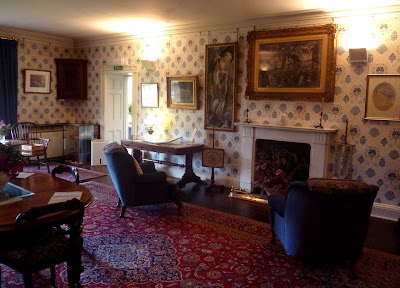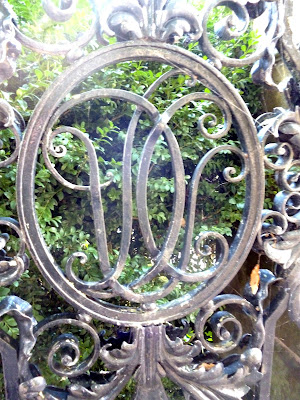Brantwood, Coniston, Cumbria. Not the most brilliant photo of an author's home I've ever taken, but there we are. The original building (much added to later) dates from the tail end of the eighteenth century, when the land was bought by Thomas Woodville. By 1852 the poet William James Linton had bought it: his second wife was the popular novelist Eliza Lynn Linton, who wrote several of her triple-deckers here. John Ruskin (1819–1900) was recovering from an illness in Matlock, Derbyshire in 1871 when he bought the property unseen for £1500: he knew where it was and the view it commanded, and although the house itself was disappointing he was more than impressed by its actual situation.
The study. Linton had knocked two rooms into one here. This was a centre of activity for Ruskin, where for instance he founded the Guild of St George to provide fair rent farms.
The wallpaper is to Ruskin's original design.
The drawing room, with the painting Zipporah to the left of the fireplace.
The bay window looking onto Coniston Water, and the septangular room leading from the drawing room, are additions dating from 1905, after Joan (Ruskin's cousin) and Arthur Severn had inherited the estate from John Ruskin.
The dining room.
Children's illustrator Kate Greenaway (1846–1907), born in Rolleston, Nottinghamshire, who was a friend of Ruskin's and who first visited Brantwood in 1883.
Plaster copy of the medallion on the Ruskin memorial at Friar's Crag, Derwent Water.
The turret, again looking out onto Coniston Water.
The bed in which Ruskin died on 20 January 1900.
Finally, images from the grave of John Ruskin in the parish church graveyard, Coniston:
'JOHN HOWARD
WHITEHOUSE 1873–1900
who saved Brantwood
as a memorial to
John Ruskin'
John Ruskin'
The study. Linton had knocked two rooms into one here. This was a centre of activity for Ruskin, where for instance he founded the Guild of St George to provide fair rent farms.
The wallpaper is to Ruskin's original design.
The drawing room, with the painting Zipporah to the left of the fireplace.
The bay window looking onto Coniston Water, and the septangular room leading from the drawing room, are additions dating from 1905, after Joan (Ruskin's cousin) and Arthur Severn had inherited the estate from John Ruskin.
The dining room.
Children's illustrator Kate Greenaway (1846–1907), born in Rolleston, Nottinghamshire, who was a friend of Ruskin's and who first visited Brantwood in 1883.
Plaster copy of the medallion on the Ruskin memorial at Friar's Crag, Derwent Water.
The turret, again looking out onto Coniston Water.
The bed in which Ruskin died on 20 January 1900.
Finally, images from the grave of John Ruskin in the parish church graveyard, Coniston:






















































